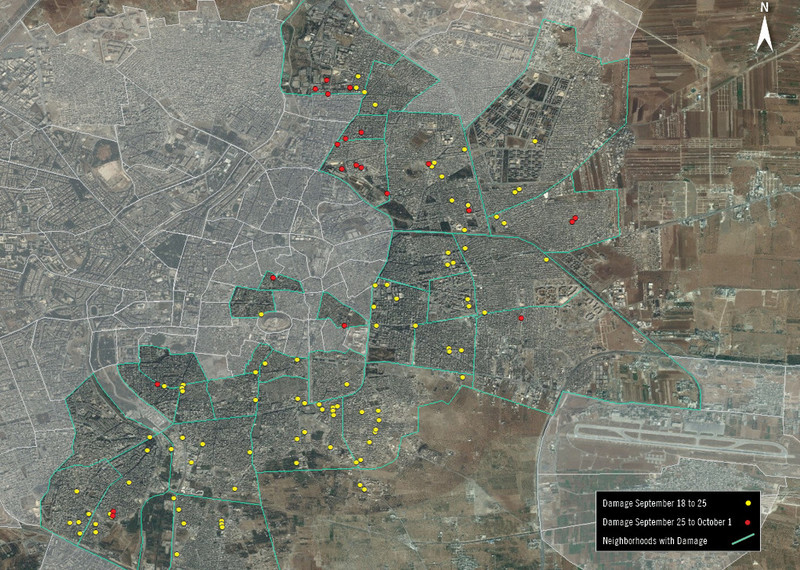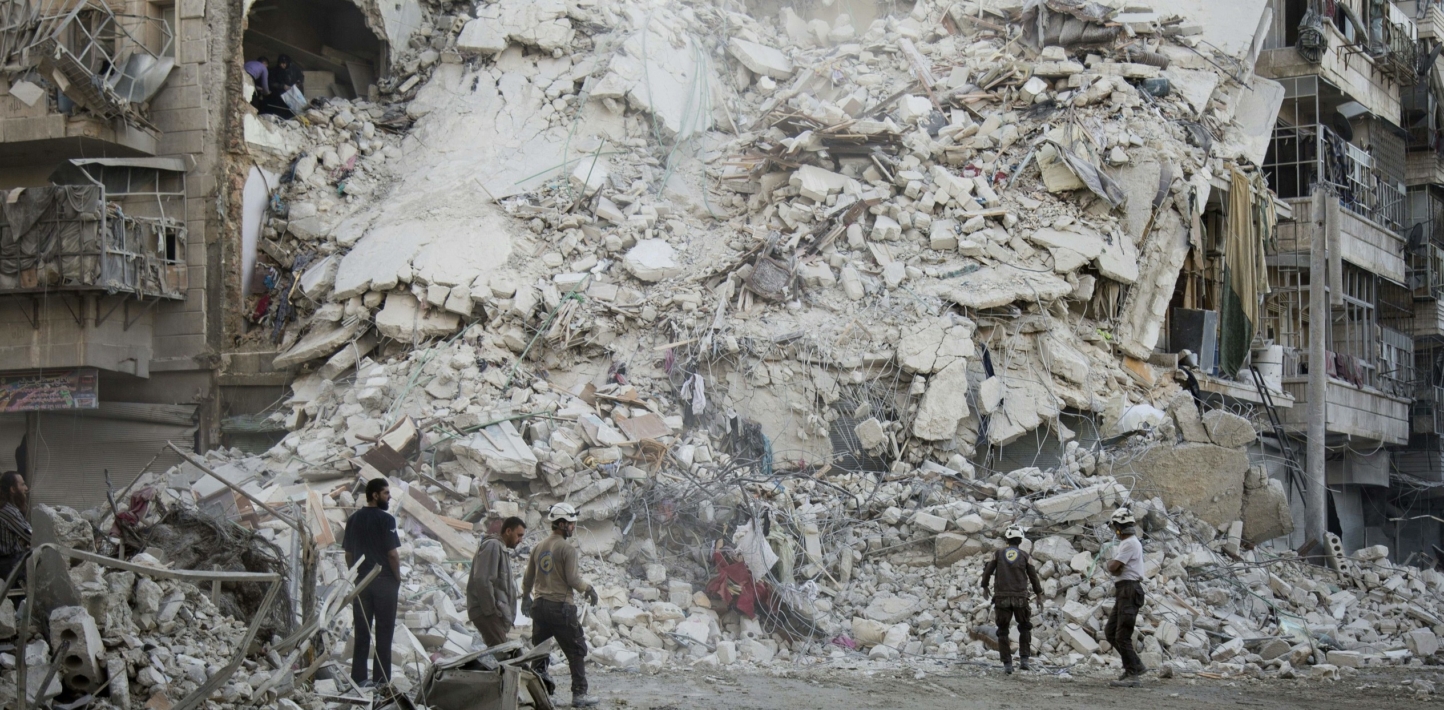To download AV material click here
The UN General Assembly (UNGA) must step in to fill the void left by the Security Council members’ catastrophic failure to end relentless attacks targeting the civilian population in eastern Aleppo city, said Amnesty International ahead of a UNGA meeting later today.
The organization has released new satellite imagery illustrating the scale of destruction, as well as testimony from civilians trapped in the city, providing evidence that Syrian government forces, with Russian support, have callously attacked residential homes, medical facilities, schools, markets and mosques as part of a deliberate military strategy to empty the city of its inhabitants and seize control. In some cases there is evidence that Russian-made cluster munitions were used in attacks.
“The world’s inaction in the face of the continuing carnage and blatant violations in Aleppo city must end. The UN General Assembly must show it can act where the Security Council has so catastrophically failed – the credibility of the UN is at stake,” said Lynn Maalouf, Deputy Director for Research at Amnesty International’s Beirut regional office.
Drone footage of Aleppo ©Aleppo Media Center
“The scale of the bloodshed and destruction wrought on eastern Aleppo city over the past month is harrowing. Syrian government forces, with the support of Russia, have launched relentless attacks that have flagrantly disregarded fundamental rules of international humanitarian law.
The world’s inaction in the face of the continuing carnage and blatant violations in Aleppo city must end
Lynn Maalouf, Deputy Director for Research in Amnesty International Middle East and North Africa Regional Office
“The woefully inadequate eight-hour pause in bombing announced by Russia is no substitute for unimpeded access for impartial humanitarian relief and an end to unlawful attacks. Member states must use today’s meeting to demand a lifting of the siege, an end to unlawful attacks, and to push for concrete measures to bring those responsible for war crimes to justice.”
Many of Aleppo’s remaining civilians live in constant fear of daily attacks. Soha, a local activist, described to Amnesty International how she takes her seven-month-old baby with her everywhere she goes as she is terrified of losing him.
“Every time I see a woman or child injured, I think it could have been me and my son. Nowhere is safe in Aleppo city, every one of us is a target,” she said.
Nowhere is safe in Aleppo city, every one of us is a target
Soha, resident of eastern Aleppo
Siham, whose four-year-old daughter was killed in the recent bombardment, described the pain of her loss to Amnesty International. Her husband was detained by government forces in 2012 before their daughter was born.
“I have lived all my life in Aleppo city… I lost [my daughter] six days ago. A bomb fell in front of the building where she was playing. I can’t remember the last words she told me… I lost her just like that for nothing…absolutely nothing. I wish I had died with her.”
The diplomatic deadlock has seen the UN Security Council paralysed as the civilian death toll in Aleppo rises by the day. Russia, with support from China, has repeatedly wielded its veto power to block any action that would see the Syrian government held accountable for grave violations, including war crimes. Less than two weeks ago a French UN draft resolution calling for an end to attacks on civilians in Aleppo failed after a Russian veto.
Seventy countries called for today’s plenary meeting sending a clear message that inaction at the Security Council must be addressed. Member states must call for an emergency session on the crisis and support all initiatives at the UNGA to bring an end to the cycle of war crimes in Syria. Imposing targeted sanctions on Syrian officials and a comprehensive arms embargo are two measures that could also help pressure the Syrian government to end violations of international humanitarian law.
Relentless attacks on civilians and civilian objects
The bombing of eastern Aleppo has intensified drastically since the collapse of the latest ceasefire on 19 September. At least 600 aerial attacks were carried out in the space of three weeks in the period up until the 10 October, according to the Syrian Institute for Justice and Accountability, a local monitoring group. Aleppo’s Health Directorate estimates around 400 civilians were killed in these attacks.
Satellite imagery analyzed by Amnesty International reveals that in just one week, 90 locations were damaged or destroyed in an area roughly the size of Manhattan, New York City. Overall more than 110 locations were damaged between 18 September and 1 October 2016.

Amnesty International documented a series of attacks over the past three weeks which appear to be aimed at decimating civilian life in Aleppo city.
Researchers from the organization spoke to residents, medical workers and activists who are trapped and who described a drastic deterioration in the humanitarian situation, amidst daily air strikes targeting civilian homes and infrastructure, including medical facilities, a market, a school, electricity and water company. The areas struck were all located away from military targets such as the battle frontline, military checkpoints or vehicles.
“Syrian government forces claim to be attacking non-state armed groups but the real objective is clear: to inflict severe suffering on the civilian population in order to drive them out. The world continues to stand by as this pattern is repeated over and over throughout Syria,” said Lynn Maalouf.
According to the Syrian American Medical Society, 14 medical facilities have been hit by air strikes since 21 September, putting many of them out of service. Doctors have been struggling to cope with an influx of large numbers of casualties in need of emergency medical treatment – at one point, 800 wounded patients needing care were recorded in one week.
One eyewitness described to Amnesty International an attack on al-Sakhour hospital on 3 October. A bomb fell at the hospital entrance leaving behind a large crater and partially destroying a nearby field hospital. It was the third attack on the hospital that day, he said:
“I arrived at al-Sakhour hospital three hours after the attack had happened… I saw 10 injured and four killed… The injured included two of the hospital’s medical staff…The closest frontline is around 300 meters away.”
A doctor in Aleppo city told Amnesty International that supplies, equipment and fuel were fast running out because of the siege.
“In Aleppo city, residents fear living or being in or around a hospital because we have become a target for the regime,” he said.
“Deliberate attacks on civilians and civilian objects are serious violations of international humanitarian law and amount to war crimes. The pattern of attacks targeting the civilian population, buildings and infrastructure of eastern Aleppo provides clear evidence that this is part of a calculated military strategy to make life unbearable for civilians and to empty the city by force,” said Lynn Maalouf
Alleged cluster munition attacks
Several residents also told Amnesty International that they had witnessed attacks using internationally banned cluster munitions, bombs that scatter scores of submunitions over a wide area posing a major threat to civilians.
Amnesty International reviewed images showing remnants of cluster bombs and submunitions in civilian areas of eastern Aleppo over the past three weeks and consulted independent weapons experts who identified these as Russian made AO-2.5RT submunitions or the very similar AO-2.5RTM, along with remnants of the RBK-500 cluster bomb from which they are dispensed.

Fadi, was getting into a car at a busy market in Zebdie district with his friend on 25 September when a warplane dropped two cluster bombs. He and his friend were both struck by shrapnel. “All I remember after that was the feeling of agonizing pain in my leg and hip. I kept hearing small explosions… People were lying on the ground. Some crawling and others not moving,” he said.
Majed, another survivor was at the same market in Zebdie which is around 500 metres away from the nearest front line when the attack took place. He recalls hearing the sound of small explosions before he woke up on the ground in shock covered in blood and surrounded by wounded people. Two pieces of shrapnel were lodged in his leg.
Osama also witnessed a cluster bomb attack on the same day as he was driving an injured friend from al-Mashhad neighbourhood to the hospital.
“I heard the sound of a warplane and then the [car’s] window pane shattered on top of us. I heard a series of small explosions that went on for almost a minute… More than 40 people were injured,” he said.
“The use of cluster munitions is banned under international law because they are inherently indiscriminate and, due to their high dud-rate, pose a long-lasting threat to civilians. Their apparent use in eastern Aleppo city is just further evidence of how determined Syrian government forces and their
Russian allies are to create a hostile and deadly environment in the city, clearly aimed at driving civilians out at any cost,” said Lynn Maalouf.


